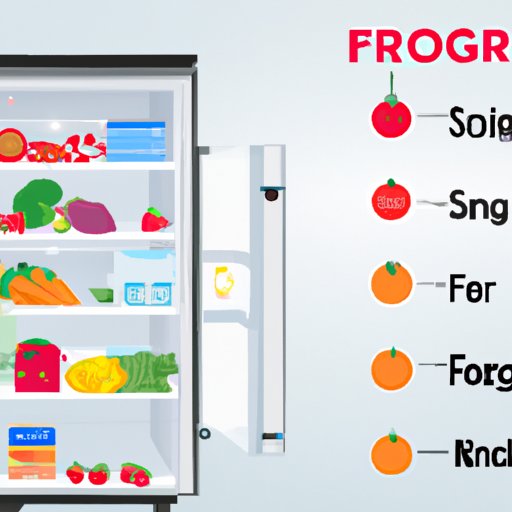Introduction
When it comes to keeping food fresh and safe to eat, proper refrigerator temperature settings are essential. A refrigerator that is not set to the correct temperature can cause food to spoil quickly and can even lead to food-borne illnesses. This article examines the optimal temperature for refrigerators, what factors affect the ideal temperature, and how to maintain the ideal temperature for maximum freshness.

Exploring the Optimal Temperature for Refrigerator Settings
The optimal temperature for a refrigerator is between 35°F and 40°F (1.7°C and 4.4°C). At this temperature, bacteria in food won’t grow as quickly and will take longer to spoil. It’s important to note that different types of food require different temperatures for optimal freshness. For example, meat and fish should be kept at a lower temperature than fruits and vegetables.
There are several factors that can affect the ideal temperature for a refrigerator. These include the size of the refrigerator, the amount of food stored in it, and the type of food being stored. Additionally, external factors such as the ambient temperature in the room can also influence the ideal temperature for a refrigerator.

Setting Your Fridge to the Right Temperature
Once you have determined the ideal temperature for your refrigerator, you can adjust the temperature accordingly. Most modern refrigerators come with a temperature control dial or digital display. To adjust the temperature, simply turn the dial or press the up or down arrow until the desired temperature is reached. If your refrigerator does not have a temperature control, consult your owner’s manual or contact the manufacturer for instructions.
When adjusting the temperature of your refrigerator, it’s important to make gradual changes. Do not jump from one extreme to another, as this can cause food to spoil more quickly. Allow the temperature to settle for a few hours before making additional adjustments.

Protecting Your Food With Proper Refrigerator Temperature Settings
It is important to remember that improper refrigerator temperature settings can result in food spoilage and even food-borne illnesses. To protect your food, avoid these common mistakes when setting refrigerator temperatures:
- Setting the temperature too low – This can cause food to freeze, which can damage the food and make it unsafe to eat.
- Setting the temperature too high – This can cause food to spoil quickly and can even allow bacteria to grow.
- Leaving the door open – This can cause the temperature inside the refrigerator to fluctuate, which can cause food to spoil quickly.
By avoiding these common mistakes, you can ensure that your food stays safe and fresh for as long as possible.
Refrigerator Temperature Tips for Keeping Your Food Fresh
In addition to setting the temperature correctly, there are several other techniques you can use to keep your food fresh and safe to eat. These include:
- Storing food in airtight containers – This helps to seal in freshness and keep food from spoiling quickly.
- Labeling food – This ensures that you know when it was purchased and can throw out expired food.
- Cleaning the refrigerator regularly – This helps to keep food fresh by removing any bacteria or other contaminants.
By following these simple tips, you can ensure that your food stays fresh and safe to eat.
Setting Your Refrigerator to the Ideal Temperature for Maximum Freshness
In order to maximize the freshness of your food, it is important to set your refrigerator to the ideal temperature. To do this, follow these steps:
- Check the temperature – Use a thermometer to check the temperature inside the refrigerator.
- Adjust the temperature – If necessary, adjust the temperature using the control dial or digital display.
- Allow the temperature to settle – Allow the temperature to settle for a few hours before making additional adjustments.
- Check the temperature again – Use a thermometer to check the temperature inside the refrigerator.
By following these steps, you can ensure that your refrigerator is set to the ideal temperature for maximum freshness.
Conclusion
A refrigerator that is not set to the correct temperature can cause food to spoil quickly and can even lead to food-borne illnesses. The optimal temperature for a refrigerator is between 35°F and 40°F (1.7°C and 4.4°C), although different types of food may require different temperatures for optimal freshness. In order to maximize the freshness of your food, it is important to set your refrigerator to the ideal temperature and follow proper storage techniques. By doing so, you can help ensure that your food stays safe and fresh for as long as possible.


